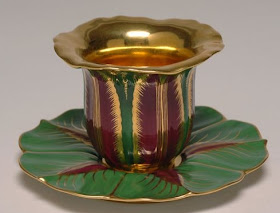Many Spode shapes and styles, following the introduction of bone china in about 1800, follow the French porcelain manufacturers, particularly Sèvres. The quality of Spode's bone china matched that of Sèvres porcelain earning a 20th century description from a former curator of the museum there: '
The Spode factory was without doubt the most important factory in the 19th century'.
The Spode 1820 Shape Book proves the styles of the company at this period followed the French as many shapes blatantly have the prefix French. Page 10 shows a
French Shape Jar made in 3 sizes. Jar is an old word for vase.
 |
| 1820 Shape Book page 10 from Spode Exhibition Online |
Page 100 shows the updated version called
New Shape French Jar. This was made in 8 sizes and was very popular with Spode's wealthy customers. It was usually decorated in spectacular style with lots of gold and cobalt and beautiful hand painted landscape scenes, portraits or floral subjects. The reverse, or 'backside' as the pattern books describe it, was usually gilded in classical style on a cobalt blue ground. This could be seen reflected in a mirror when displayed against one, for example on a mantelpiece.
 |
| 1820 Shape Book page 100 from Spode Exhibition Online |
 |
| Decorated New Shape French Jar (front) |
 |
Decorated New Shape French Jar ('backside')
(used on the cover of a book on Spode) |
Other shape names include
Paris and
Sèvres in their description. In the Spode museum collection there is a pair of cups and saucers in the shape of a plant. I thought them beautiful the moment I saw them when I first unpacked them from a box prior to display in the 1990s; and immediately showed how little I knew as I thought they were from about 1870! But I soon discovered they were made in about 1816.
 |
| Spode 'Tulip Cup' c1816 |
The design is in the pattern books simply with an illustration and the pattern number 2395. I have included my very, very poor snapshot of one on display. In the museum catalogue they were described as 'Tulip Cups' - a description I was never happy with as they don't really look like tulips...
Imagine my delight when I found one recently in the
Sèvres Museum collection! The Spode version has less gold inside but there is no doubt the company was following the French style. I was fascinated to learn about this cup described as 'tasse cobéa'.
What was it? Of course cobéa is a plant but one I didn't know and it has the delightful common name of 'cup-and-saucer vine'. What could be more appropriate? And can you forgive me for thinking is was late 19th century?
 |
Cobaea scandens
(Click the caption for the wonderful Digital Botanic Gardens blog) |







